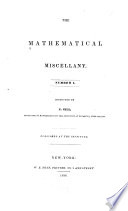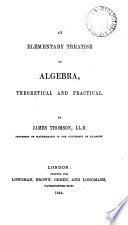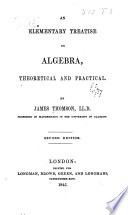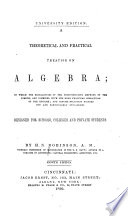 | Mathematics - 1836 - 798 pages
...arranged according to the powers of any letter in it, and if, in that form, the second term is equal to twice the product of the square roots of the first and third terms, then that trinominal is the square of a binominal formed by connecting the roots of the first andthird... | |
 | James Thomson - 1844 - 328 pages
...62 = 4«e. This is evident from § 151. ; for we saw there, that when a trinomial is a square, its middle term is twice the product of the square roots of the first and third. Hence, that ax* i-bx+c may be a square, we must have to=2o5c% ; and from this, by dividing by x, and... | |
 | Horatio Nelson Robinson - Algebra - 1844 - 184 pages
...preceive 1st. That it consists of three terms. 2d. Two of these terms, the first and last are squares. 3d. The middle term is twice the product of the square roots of the first and last. Now let us suppose that a2 is lost, and we have only x2-\-2a&'. We know these terms cannot make... | |
 | James Thomson - Algebra - 1845 - 328 pages
...if 62 = 4ac. This is evident from § 151. ; for we saw there, that when a trinomial is a square, its middle term is twice the product of the square roots of the first and third. Hence, that ax2 + bx + c may be a square, we must have bx=i2.a*eix ; and from this, by dividing by... | |
 | Horatio Nelson Robinson - Algebra - 1846 - 276 pages
...1st. That it consists of three terms; 2d. Two of its terms, the first and the third, are squares; 3d. The middle term is twice the product of the square roots of the first and last term. Now let us suppose the third term, a3, to be lost, and we have only xa-|-2ax. We know these... | |
 | Charles William Hackley - Algebra - 1846 - 542 pages
...• 9a«— 48a<62+64asi< is a perfect square ; for the two extreme terms are perfect squares, and the middle term is twice the product of the square roots of the extreme terms; hence the square root of the trinomial is Or, . Sa^—Sab*. An expression such as 4a!+... | |
 | Horatio Nelson Robinson - Algebra - 1848 - 354 pages
...1st. That it consists of three terms; 2d. Two of its terms, the first and the third, are squares; 3d. The middle term is twice the product of the square roots of the first and last term. Now let us suppose the third term, a2, to be lost, and we have only x*-\-2ax. We know-these... | |
 | Joseph Ray - Algebra - 1848 - 252 pages
...trinomial can be separated into two binomial factors, when the extremes are squares and positive, and the middle term is twice the product of the square roots of the extremes. See Articles 79 and 80. Thus: a'+2ab+b*=(a+b)(a+b). a'—2ab+b'=(a—b)(a—b). 2d. Any binomial,... | |
 | Horatio Nelson Robinson - Algebra - 1850 - 358 pages
...consists of three terms; 2d. Two of its terms, the first and the third, are squares; 3d. The middle tern is twice the product of the square roots of the first and Isfst term. Now let us suppose the third term, a 2 , to be lost, and we have only x2-\-2ax. We know... | |
 | Joseph Ray - Algebra - 1848 - 250 pages
...trinomial can be separated into two binomial factors. when the extremes are squares and positive, and the middle term is twice the product of the square roots of the extremes. Se» Articles 79 and 80. Thus: o*+2ab+^=(a+b)(a+b). a2— 2a6+6*=(a— b)(a— 6). 2d. Any... | |
| |